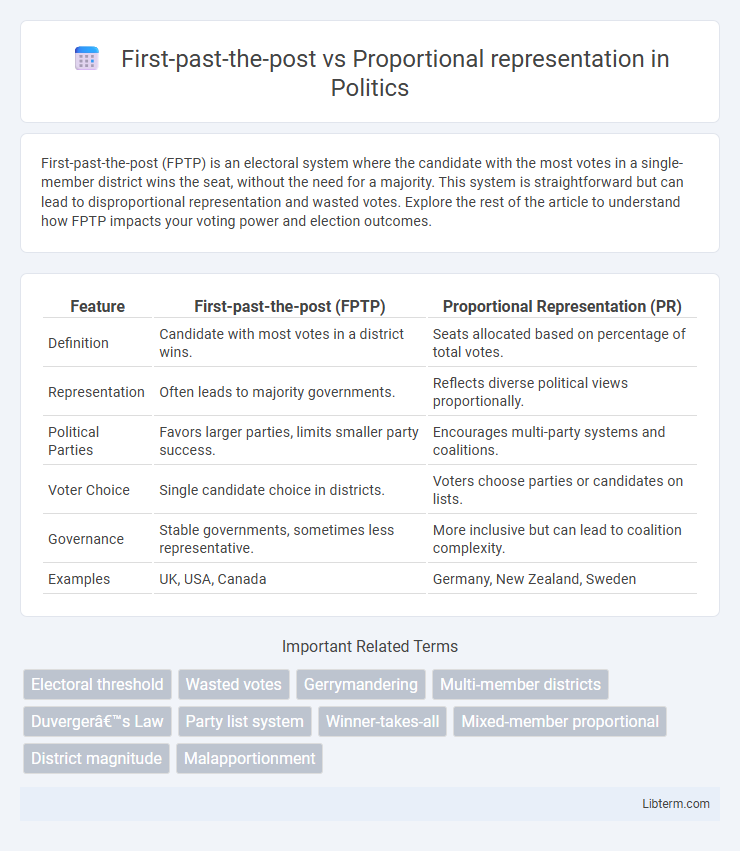First-past-the-post (FPTP) is an electoral system where the candidate with the most votes in a single-member district wins the seat, without the need for a majority. This system is straightforward but can lead to disproportional representation and wasted votes. Explore the rest of the article to understand how FPTP impacts your voting power and election outcomes.
Table of Comparison
| Feature | First-past-the-post (FPTP) | Proportional Representation (PR) |
|---|---|---|
| Definition | Candidate with most votes in a district wins. | Seats allocated based on percentage of total votes. |
| Representation | Often leads to majority governments. | Reflects diverse political views proportionally. |
| Political Parties | Favors larger parties, limits smaller party success. | Encourages multi-party systems and coalitions. |
| Voter Choice | Single candidate choice in districts. | Voters choose parties or candidates on lists. |
| Governance | Stable governments, sometimes less representative. | More inclusive but can lead to coalition complexity. |
| Examples | UK, USA, Canada | Germany, New Zealand, Sweden |
Introduction to Electoral Systems
First-past-the-post (FPTP) electoral systems award victory to the candidate with the most votes in a single-member district, often resulting in disproportionate representation favoring larger parties. Proportional representation (PR) systems allocate seats based on the percentage of votes each party receives, promoting a more accurate reflection of voter preferences across multi-member districts. Understanding these contrasting mechanisms highlights their impact on political diversity, governance stability, and voter representation within democratic processes.
What is First-Past-The-Post (FPTP)?
First-Past-The-Post (FPTP) is an electoral system where the candidate with the most votes in a single-member district wins the seat, without needing a majority. This plurality voting method often leads to a two-party system by favoring larger parties and can result in disproportional representation between votes cast and seats won. FPTP is widely used in countries like the United Kingdom, the United States, and Canada, influencing political stability and governance structures.
Principles of Proportional Representation (PR)
Principles of Proportional Representation (PR) emphasize equitable representation by allocating seats based on the percentage of votes each party receives, ensuring minority groups have a voice in the legislature. PR systems are designed to reduce the distortion seen in First-past-the-post (FPTP) voting, where candidates win by plurality in individual districts, often leading to disproportionate majorities. By reflecting voter preferences more accurately, PR promotes fairness, inclusivity, and a multiparty political landscape.
Key Differences Between FPTP and PR
First-past-the-post (FPTP) electoral systems award victory to the candidate with the most votes in single-member districts, often leading to majority governments and underrepresentation of smaller parties. Proportional representation (PR) allocates seats based on the percentage of votes each party receives, promoting multi-party representation and better reflecting voter preferences. FPTP generally produces stable governments but can distort overall voter intent, whereas PR enhances fairness and diversity at the potential cost of political fragmentation.
Advantages of First-Past-The-Post
First-past-the-post (FPTP) promotes political stability by often producing majority governments, reducing the likelihood of coalition negotiations and legislative gridlock. It simplifies the voting process and creates a direct link between representatives and their constituencies, enhancing accountability and voter engagement. FPTP tends to favor larger parties, which can contribute to clearer policy direction and consistent governance compared to proportional representation systems.
Benefits of Proportional Representation
Proportional representation ensures that political parties gain seats in proportion to the votes they receive, enhancing fairness and voter satisfaction. It promotes diverse and inclusive governance by enabling smaller parties and minority groups to secure representation. This system reduces wasted votes and encourages higher voter turnout by making every vote count towards seat allocation.
Criticisms and Drawbacks of FPTP
First-past-the-post (FPTP) often leads to disproportional representation, where parties win a majority of seats without a majority of votes, undermining electoral fairness. This system marginalizes smaller parties and minority groups, resulting in wasted votes and limited political diversity. The winner-takes-all nature of FPTP can also encourage tactical voting and reduce voter turnout due to perceived vote inefficacy.
Challenges of Implementing PR Systems
Implementing Proportional Representation (PR) systems faces significant challenges such as complex ballot designs and vote counting procedures that can confuse voters and slow down election results. PR systems often result in fragmented legislatures, making coalition governments necessary and potentially leading to political instability or ineffective policymaking. Additionally, transitioning from First-past-the-post (FPTP) to PR requires substantial legal reforms and political consensus, which can be difficult to achieve in entrenched political environments.
Global Examples: FPTP vs PR in Practice
First-past-the-post (FPTP) systems, prominent in countries like the United States, United Kingdom, and India, often produce majority governments but can marginalize smaller parties, leading to disproportional representation. Proportional representation (PR) models, as seen in Germany, Sweden, and New Zealand, allocate seats based on the percentage of votes received, enhancing political diversity and reflecting voter preferences more accurately. Comparative studies highlight that PR systems tend to increase voter turnout and minority representation, whereas FPTP may result in stable governments but with significant vote-seat disparities.
Future Trends and Debates in Electoral Reform
Electoral reform debates increasingly center on balancing First-past-the-post (FPTP) simplicity with Proportional Representation's (PR) inclusivity, as emerging democracies and established nations explore hybrid models to enhance voter representation and reduce political polarization. Future trends indicate growing advocacy for Mixed-Member Proportional systems and Single Transferable Vote reforms to address FPTP's disproportionality and PR's party fragmentation challenges. Technological advancements like blockchain voting and AI-driven constituency mapping could further transform electoral systems, promoting transparency and adaptive proportionality in upcoming elections.
First-past-the-post Infographic

 libterm.com
libterm.com